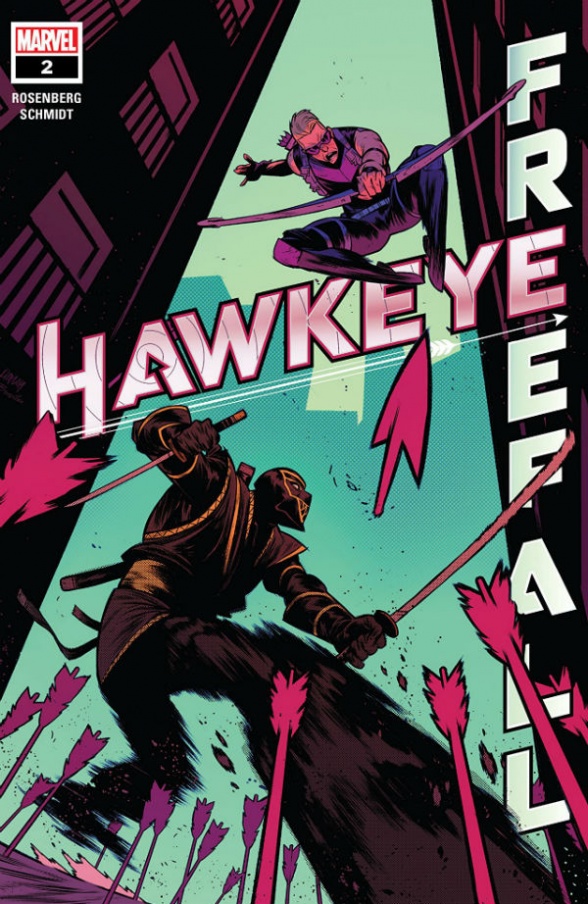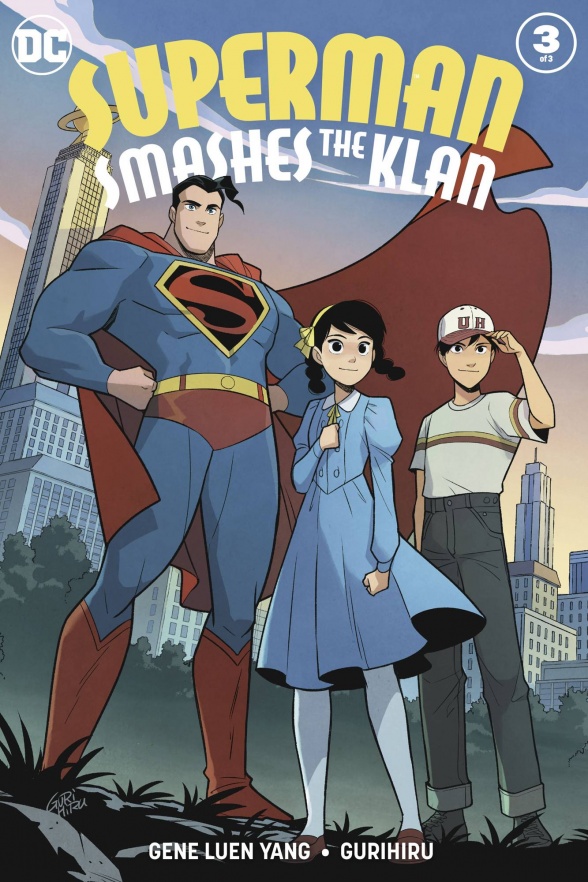
Welcome to the Multiversity Year in Review for 2020! While this has been, by many accounts, a terrible year, there were a number of fantastic comics released in 2020, and over the next ten days, we’ll be highlighting our favorites across 25 categories. If you want to give your thoughts on our picks or share your own, feel free to do so in the comments!
Best Limited Series
There are lots of comics that roll on and on indefinitely. Then there is the miniseries. Generally defined as a series planned to be fewer than 12 issues long, these are comic stories planned with a definitive beginning, middle, and end. 2020 made fools out of anyone with a plan, but there were nevertheless a great number of series that met our criteria. Well we got together and debated and negotiated and compromised, and we came up with a solid list of stories that make up our top limited series of 2020.

5. Hawkeye: Freefall
Here’s a hot take: “Hawkeye: Freefall” is the best Hawkeye story arc in a decade, and yes, I know what it stands against (that’s why I said ‘arc’ and not ‘run’). And I am not saying this lightly, I know this has been the best decade to Marvel’s archer, but what Matthew Rosenberg and Otto Schmidt did with this book was spectacular.
First of all, Schmidt’s art was amazing, his particular style was perfect for the script, he draws extremely dynamic movements; he got to draw a ton of other heroes and villains trough the six issues of this mini and yet, the best thing he showed us was Clint Barton’s face trough the series, Schmidt showed how Barton was falling down both emotionally and physically, from the first issue’s smirk to showing, even with the mask on, all the bandages from the punches received. Plus, he showed us truly scary images, including the paranormal (the cowl’s demon), and the human, like sidekick Bryce’s fatal injuries.
And I don’t know why doesn’t Rosenberg gets to write one of the main Marvel books, his work here was majestic, we had hilarious scenes, like Barton picking up his arrows, mixed up with very tense moments as we see our hero becoming a villain. Rosenberg tackled themes rarely seen in the genre, like becoming obsessed with a villain to the point that even a hero can make mistake after mistake, betraying fellow Avengers, overcomplicating things and choosing questionable paths, Hawkeye acted here as a villain to defeat a villain… after all, he was originally conceived as that.
After this book we are eager to know what is coming next for Clint Barton, now that he has truly hit rock bottom. – Ramon Piña

4. Billionaire Island
Mark Russell is consistently one of the best writers in comics for his wit, insight, and ability to be absolutely scathing to reality without having the actual veneer of the story peel away. Because of this, his stories often read as just a few steps removed from reality but instantly recognizable. “Billionaire Island,” illustrated with equal brilliance by his “The Flintstones” partner Steve Pugh, promised to be the same, turning his satire up to 11 with a fictional world that would be harder to see as existing today but easy to imagine coming to be, the hallmark of excellent speculative fiction. The first issue came out and we got what was promised.
Then the pandemic hit and the series suddenly read very differently, more documentary of the Rich & Ultra-Rich (it’s obscene that I have to have two categories here) than what-if satire.
While this may have killed a lesser book, “Billionaire Island” instead comes out the other end stronger, fiercer and sticking with you for long after the series wraps. The comedy hits just as hard and the commentary holds a greater purchase, as it feels more urgent than ever. It’s a call to action that we address the systemic issues that have provided the perfect petri dish to breed this unique form of capitalistic parasite that cares not for people. Or, it cares for people, but only those with a billion dollars or more. The rest aren’t people, just fodder.
Continued belowIt’s a bleak message but it’s not a bleak series, and that is what makes it so powerful. Eat (or at the very least tax) the rich, defund the police, and for G-d’s sake, socialize the healthcare system. Otherwise, we’ll all be living in the world of “Billionaire Island,” if we’re not already there. – Elias Rosner

3 (tie). Superman’s Pal: Jimmy Olsen
Despite the fact that it was written long before the COVID-19 pandemic, few comics capture the scattered, frantic energy of 2020 better than “Superman’s Pal Jimmy Olsen”. Throughout its twelve-issue run, it told a sprawling tale across multiple time periods across short vignettes dripping with character and humour. Whether you’re looking for something short and funny or a compelling story about family and legacy, “Superman’s Pal JImmy Olsen” can give you what you need.
Jimmy Olsen has been a part of Superman canon for decades, and played many roles in the comics in that time. The creative team behind “Superman’s Pal Jimmy Olsen” lean into his fluid and often zany nature to deliver a manic tale that begins (kind of?) with Jimmy Olsen (transformed into a turtle, of course) skydiving from space only to crash into a treasured statue in Metropolis, and ends…well, you’ll have to read it to find out. The story moves along through short scenes, no longer than a few pages. Each of these snippets works on its own, but also forwards the overarching narrative in some way. Sometimes you’re introduced to a new character. Sometimes more of the grand mystery is unveiled. Matt Fraction doses out the story in precisely-measured quantities, and Steve Lieber coats these in a charming aesthetic that adds to the absurdity of it all.
From the first issue to the last, “Superman’s Pal Jimmy Olsen” is a joy to read. Once you get used to the style of story delivery, it is incredibly satisfying. Whether you read every DC book or this is your first trip to Metropolis in a long while, this book is well worth your attention. – Jodi Odgers

3 (tie). Far Sector
America’s reckoning with police violence has been long overdue. Several new cases of police brutality against black citizens and activists drove another wave of Black Lives Matter protests this year, this time reaching nearly every major city in the country and sparking solidarity protests around the globe. As the summer stretched on, it became clear that familiar crime stories, with hero cops fighting against dastardly criminals, are not going to cut it anymore.
Enter “Far Sector,” this year’s most topical series, a sci-fi noir that digs into the contradictions of policing—and of superheroism—that place one individual as a powerful authority over another in the service of a slippery definition of right and wrong. N.K. Jemisin and Jamal Campbell crafted the perfect modern recruit for DC’s longstanding space cops in Sojourner “Jo” Mullein, a Green Lantern who is a veteran of American prejudice and knows an abusive bureaucracy when she sees one. Jo is brash and emotional, everything that the government of the emotion-free planet at the edge of the universe dislikes. She’s also a pretty compelling detective and the best new hero DC has introduced in years.
George Floyd was killed on May 25, and the protests that followed are extremely reminiscent of issues of “Far Sector” that were released in January–this isn’t a prescient book, however. Although Campbell’s gorgeous spreads of the City Enduring are Afro-futuristic, the book offers a cutting analysis of the cruelties and abuses of the past that brought us to our present reality, underscoring the science fiction with images of Japanese internment and Nixon’s campaign posters. “Far Sector” links that past to questions that challenge the very underpinnings of the superhero genre. It’s a testament to what can happen when you bring in underrepresented perspectives to tackle familiar concepts—they’ll show you a side of those stories that you’ve never been able to see before. -Reid Carter

2. Wonder Woman Dead Earth
When “Wonder Woman: Dead Earth” was announced, anticipation started building immediately. Daniel Warren Johnson, with his regular coloring partner, Mike Spicer, and letterer Rus Wooton, were going to have free reign in the DC sandbox thanks to the Black Label. It was a tantalizing prospect and one that, as evidenced by its inclusion on this list, did not disappoint.
Continued below“Wonder Woman: Dead Earth” is a rare series that feels truly groundbreaking because it gives you a different perspective on a well-known character by pushing them to their breaking point and beyond. Johnson posits Diana firmly between humanity and the Amazons after the end of civilization as we know it, with her being pulled excruciatingly in both directions. Diana’s navigation of the situation makes for an extremely compelling read, with her not always making the decision you expect, but one that is always driven by understandable motivations.
On top of this story, of course, is Daniel Warren Johnson’s artwork. His decision to wrap the post-apocalyptic world in a medieval aesthetic is a masterstroke. It clashes the modern, grandiose, and recognisable DC characters and settings against that of a dangerous, brutal, and bygone era for a visual feast. With monstrous Haedra frequently arriving, there’s no shortage of action either and Johnson utilises the larger page size to overwhelming effect. Mike Spicer’s color palette ensures that the locations are dark and grimy and the action sequences are vibrant. Rus Wooton’s lettering is fantastic throughout, guiding the reader through dense panel layouts with ease.
Everything points to “Wonder Woman: Dead Earth” being a major milestone in Wonder Woman history, with its influence already manifesting in upcoming projects, making it one of the Best Limited Series of 2020. -Luke Cornelius

1. Superman Smashes the Klan
If you want to know just how good “Superman Smashes the Klan” is, consider both its release schedule and its place on both our 2019 and 2020 Best Limited Series lists. By the time we had written up 2019’s list, only one issue was out, and it still placed #7 on our list. In 2020, just one issue was released, and yet the series ranks #1. Given that between then and now our entire world has suffered devastating losses, intense racial injustice, political upheaval, and Tiger King, the fact that we still remember a comic that hasn’t come out since February, and remember it well enough to grant it our top spot here is a testament to Gene Luen Yang and Gurihiru’s work.
In book tone and look, this series returns Superman to a former state, when he wasn’t always saving the universe, but instead saving lives. Not all lives are saved by flying away from danger, either. Here, Superman helps save lives that are hampered by oppression as well as those entombed by hatred and bigotry. The very concept of Superman – an alien who assimilates to avoid being other-ized – is placed against people who can’t hide the fact that they come from another land. Yang uses this concept to allow his young protagonist, in some ways, to be the truly super character.
All of this is elevated by Gurihiru’s magnificently expressive and playful art. The dark moments are frightful, but never hopeless, as the eyes of both Superman and Roberta never let you forget that there are better ways to do things, and ways out of this mess. The messages of hope and tolerance may seem trite or simplistic in the complicated and difficult world that we live in, but Yang and Gurihiru refuse to accept that the values of Superman shouldn’t be the values of all, and position this book as a testament and testimony to just what we can do for ourselves and each other. – Brian Salvatore






